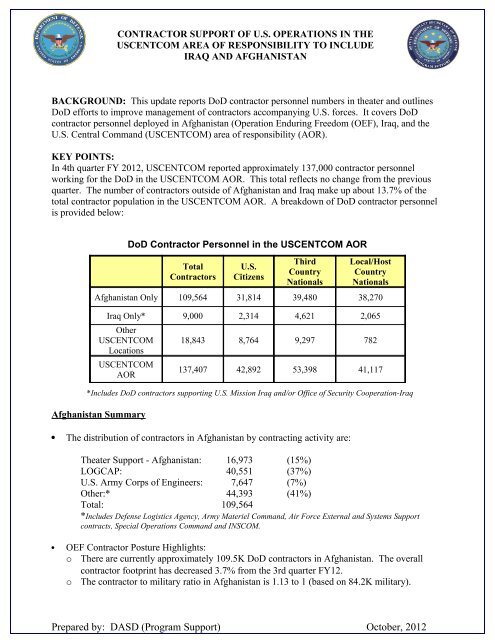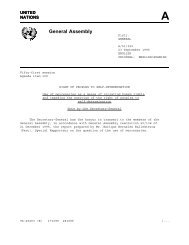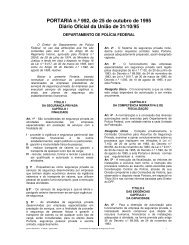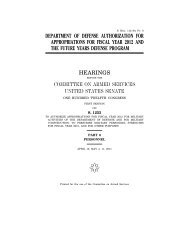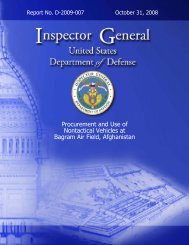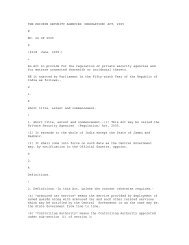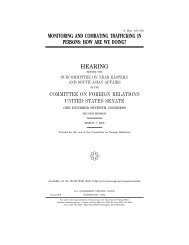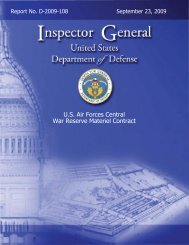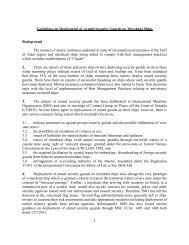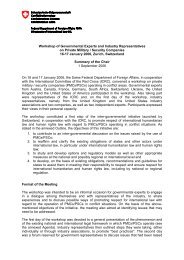October 2012 - Private Security Monitor
October 2012 - Private Security Monitor
October 2012 - Private Security Monitor
Create successful ePaper yourself
Turn your PDF publications into a flip-book with our unique Google optimized e-Paper software.
CONTRACTOR SUPPORT OF U.S. OPERATIONS IN THEUSCENTCOM AREA OF RESPONSIBILITY TO INCLUDEIRAQ AND AFGHANISTANBACKGROUND: This update reports DoD contractor personnel numbers in theater and outlinesDoD efforts to improve management of contractors accompanying U.S. forces. It covers DoDcontractor personnel deployed in Afghanistan (Operation Enduring Freedom (OEF), Iraq, and theU.S. Central Command (USCENTCOM) area of responsibility (AOR).KEY POINTS:In 4th quarter FY <strong>2012</strong>, USCENTCOM reported approximately 137,000 contractor personnelworking for the DoD in the USCENTCOM AOR. This total reflects no change from the previousquarter. The number of contractors outside of Afghanistan and Iraq make up about 13.7% of thetotal contractor population in the USCENTCOM AOR. A breakdown of DoD contractor personnelis provided below:DoD Contractor Personnel in the USCENTCOM AORTotalContractorsU.S.CitizensThirdCountryNationalsLocal/HostCountryNationalsAfghanistan Only 109,564 31,814 39,480 38,270Iraq Only* 9,000 2,314 4,621 2,065OtherUSCENTCOMLocationsUSCENTCOMAOR18,843 8,764 9,297 782137,407 42,892 53,398 41,117*Includes DoD contractors supporting U.S. Mission Iraq and/or Office of <strong>Security</strong> Cooperation-IraqAfghanistan SummaryThe distribution of contractors in Afghanistan by contracting activity are:Theater Support - Afghanistan: 16,973 (15%)LOGCAP: 40,551 (37%)U.S. Army Corps of Engineers: 7,647 (7%)Other:* 44,393 (41%)Total: 109,564*Includes Defense Logistics Agency, Army Materiel Command, Air Force External and Systems Supportcontracts, Special Operations Command and INSCOM.OEF Contractor Posture Highlights:o There are currently approximately 109.5K DoD contractors in Afghanistan. The overallcontractor footprint has decreased 3.7% from the 3rd quarter FY12.o The contractor to military ratio in Afghanistan is 1.13 to 1 (based on 84.2K military).Prepared by: DASD (Program Support) <strong>October</strong>, <strong>2012</strong>
oLocal Nationals make up 34.9% of the DoD contracted workforce in Afghanistan.Iraq SummaryContractor Posture Highlights:o The total number of contractors supporting the U.S. Government in Iraq (DoD+DoS) isnow approximately 13.5K, which meets the USG goal of reducing the contractor populationat the end of FY <strong>2012</strong>.oThe Department of Defense and Department of State continue to refine the requirements forcontract support. Some contractor personnel employed under DoD contracts are supportingState Department and other civilian activities under the Chief of Mission, Iraq. These DoDcontractors are provided on a reimbursable basis.General Data on DoD <strong>Private</strong> <strong>Security</strong> Contractor Personnel in Iraq and Afghanistan<strong>Private</strong> security contractors perform personal security, convoy security, and static securitymissions. Not all private security contractor personnel are armed.USCENTCOM reports, as of 4th quarter FY <strong>2012</strong>, the following distribution of private securitycontractors in Afghanistan and Iraq:DoD <strong>Private</strong> <strong>Security</strong> Contractor Personnel in Iraq and AfghanistanThird Local/HostU.S.TotalCountry CountryCitizensNational NationalDoD PSCs in Iraq* 2,116 102 1,823 191DoD PSCs inAfghanistan*18,914 2,014 1,437 15,413*These numbers include most subcontractors and service contractors hired by primecontractors under DoD contracts. They include both armed and unarmed contractors.In Afghanistan, the Afghan Public Protection Force (APPF) Advisory Group is developing theplanning for contracts to transition to the APPF in accordance with Presidential Decree 62. Theoriginal intent was for all convoy and development contracts to transition by 20 March <strong>2012</strong>,however, this timeline has been extended to enable the APPF to come to full operationalcapability. The APPF Advisory Group has established a transition plan to facilitate the transitionof security for development sites and convoys. International <strong>Security</strong> Assistance Force (ISAF)fixed site and military construction PSC contracts have until 20 March 2013 to be transitioned tothe APPF.Prepared by: DASD (Program Support) <strong>October</strong>, <strong>2012</strong>
ooOn May 22, <strong>2012</strong>, DoD issued instructions (PGI) to the DFARS requiring compliance withthe ANSI PSC standard for combat operations and other contingency operationsStandards and provision for third party certification in Section 833 of the FY 2011 NDAAwill facilitate identifying technically acceptable contractors and best value which: enablesexpedited contract award; mitigates risk of delay of services due to contract award protests;and, mitigates risk of contractor non-performance or misconduct in critical early phases ofcontingency operations.Joint Theater Support Contracting Command (JTSCC). JTSCC has centralized oversightand authority to ensure all contracts executed in Iraq, Afghanistan, Pakistan and Kuwait arevisible and in compliance with contracting policy and procedures. JTSCC headquarters is locatedin Qatar and facilitates broader theater contracting oversight functions. There are two Flag/GOofficers assigned to JTSCC; the Commander and the Senior Contracting Officer (SCO) inAfghanistan.JP 4-10 (Operational Contract Support). The Joint Staff J4 has established a working groupto embark on the revision of JP 4-10 (Operational Contract Support) which serves as the doctrinefor planning, conducting, and assessing operational contract support integration and contractormanagement functions in support of joint operations. Writing teams are currently staffing draftrevisions to this doctrine which was originally published in <strong>October</strong>, 2008.DoD Directive (DoDD) 3020.49 on Orchestrating, Synchronizing, and Integrating ProgramManagement of Contingency Acquisition Planning and its Operational Execution wassigned on March 24, 2009. It establishes policy and assigns responsibilities for programmanagement for the preparation and execution of acquisitions for contingency operations, andfor the accountability, integration and management of all contractors supporting the DoD and allUSG PSCs operating in an area of contingency operations.DoDI 3020.50, “<strong>Private</strong> <strong>Security</strong> Contractors (PSCs) Operating in ContingencyOperations, Humanitarian or Peace Operations, or Other Military Operations orExercises” was signed on August 1, 2011. On August 11, 2011, a final rule entitled “U.S.Government <strong>Private</strong> <strong>Security</strong> Contractors Operating in a Contingency Operations, CombatOperations or Other Significant Military Operations,” applying to all US Agencies, waspublished in the Federal Register (32 CFR Part 159). This Rule / DoDI prescribes the selection,accountability, training, equipping, and conduct of personnel performing private securityfunctions under a covered contract in a designated area of combat operations for both DoD andother agency PSCs. It also prescribes incident reporting, use of and accountability forequipment, RUF, and a process for the discipline or removal, as appropriate, of USG PSCpersonnel. The DoDI responds to requirements of section 862 of the FY 2008 NDAA asamended.Operational Contract Support (OCS) Functional Capabilities Integration Board (FCIB).This senior executive-level governance forum was chartered by the Under Secretary of Defense(Acquisition, Technology & Logistics), in March 2010 to provide strategic leadership to multiplestakeholders working to institutionalize OCS. Co-chaired by the Deputy Assistant Secretary ofDefense (Program Support) [DASD(PS)] and Joint Staff, Vice Director J-4, the FCIB convenesquarterly (or as required) to address strategic issues directly impacting current and futurecontingency operations. On June 12, <strong>2012</strong>, DASD (PS) and VD J4 convened the 3rd quarterPrepared by: DASD (Program Support) <strong>October</strong>, <strong>2012</strong>
FY12 OCS FCIB Principals meeting. Key topics of discussion included 1) a proposal tocomplete an OCS Action Plan by September 30, <strong>2012</strong>; 2) Defense Contract ManagementAgency (DCMA) alternative strategy for executing contract quality assurance in futurecontingency operations; 3) <strong>2012</strong> DCMA Combat Support Agency Review Team (CSAR) FinalReport recommendations, and 4) On-going efforts to streamline oversight and reporting of DoDefforts to implement applicable Commission on Wartime Contracting recommendations. TheBoard fully endorsed the proposal to develop a comprehensive OCS Action Plan. The plan,when finalized, will identify steps the Department will take during 2013-2017 to close the 10most critical OCS gaps, offices of primary responsibility, near-term cost, and performancemeasures. For additional information please contact the Board Secretariat at PS_FCIB@osd.mil.Joint Contingency Acquisition Support Office (JCASO). DASD (Program Support) hasinstitutionalized this organization to perform program management of Operational ContractSupport (OCS) and to provide a pre-planned approach for planning and implementing OCSpolicy and doctrine. JCASO provides a joint enabling capability to integrate, coordinate andsynchronize OCS during peacetime, contingency operations, and post-conflict operations.Planning, implementation, and oversight of OCS are Commander's responsibilities and areessential to establishing a strategy for managing contractors on the battlefield as part of the DoDTotal Force. JCASO has a deployable capability known as the Mission Support Teams and maybe requested to provide OCS planning and PgM during peacetime, contingency and post-conflictoperations. JCASO is also an essential part of DLA's combat support agency (CSA) role tosupport the mission objectives of the combatant commands, the Chairman, Joint Chiefs of StaffTitle 10 responsibilities, as well as the Office of the Secretary of Defense for OCS policy andjoint doctrine development and implementation. Examples of JCASO engagements include: a)leading and managing the economic development initiative (i.e., local procurements) in theCentral Asian States in support of the Northern Distribution Network (NDN) strategy in theUSCENTCOM AOR; b) leading and managing the Afghanistan Contracting TransitionWorkgroup (ACTW) to facilitate the interagency coordination for planning and transitioningOCS from DoD to DoS; c) deploying a team to Afghanistan to assist with the OCS drawdowneffort in support of Operation Enduring Freedom, and; d) participating in joint exercises in <strong>2012</strong>(e.g., PANAMAX, Ulchi Freedom Guardian) to integrate OCS in training and validate theeffectiveness of OCS plans.Chairman of the Joint Chiefs of Staff Notice (CJCSN) 4130.01, "Guidance for CombatantCommander Employment of Operational Contract Support Enabler-Joint ContingencyAcquisition Support Office (JCASO)" was signed on December 20, 2011. It recognizes the roleof JCASO as providing Geographic Combatant Commands and their subordinate commandswith a capability to integrate, implement, manage, and execute OCS activities to improve DoDefficiency and effectiveness across the Total Force.JCASO Concept of Operations (CONOPS). A detailed CONOPS was signed on 27 June<strong>2012</strong>, which further conveys JCASO's mission, role, and responsibility in OCS, to satisfyCombat Support Agency Review Team findings, and to complement the CJCSN 4130.01. It willdetail how JCASO engagement can help improve effectiveness and efficiency in managing OCSacross DoD and whole of government.JCASO Contingency Contracting Office (CCO): JCASO is establishing a Defense LogisticsAgency (DLA) contingency/expeditionary contracting capability that responds to demandsignals from Combatant Commands and deployed forces; complements Services’ contractingcapabilities; extends and leverages existing DLA/JCASO capabilities; develops commonPrepared by: DASD (Program Support) <strong>October</strong>, <strong>2012</strong>
operating pictures to support synchronization of all DLA contracting efforts; takes aprogrammatic approach to contracting, supporting any part of the acquisition cycle (policy,planning, requirements development, market research, contracting, or transition to civilauthority); focuses on whole-of-government humanitarian assistance, disaster recovery (HA/DR)and counter-insurgency (COIN) operations; furthers best practices and use of ContingencyBusiness Environment (CBE) tools, such as the Synchronized Pre-Deployment & OperationalTracker (SPOT), the Government Purchase Card (GPC), and the Joint Contingency ContractingSystem (JCCS); and supports SECDEF OCS and budget initiatives. CCO Initial OperatingCapability is planned in <strong>October</strong> <strong>2012</strong>.JCASO Planners. Fourteen (14) JCASO planners are allocated among the GeographicCombatant Commands to assist the commander in identifying gaps where contractor supportcapability may be required. They then help to integrate required contractor support intooperational plans and synchronize requirements with subordinate commands, the MilitaryDepartments, Defense Agencies, other USG Agencies, and coalition partners. The Secretaryfurther directed an additional 146 planners / analysts to be integrated into the total force. Theplanners have been instrumental in integrating OCS into Combatant Command plans. InUSCENTCOM alone, the planners were fundamental in the establishment of the JTSCC,planning the DoD to DoS transition in Iraq, Pakistan humanitarian efforts, increased operationsin Afghanistan, as well as other critical operations supporting USCENTCOM’s theaterengagement strategy. Based on demonstrated need for OCS planning capability in theCombatant Commands, DLA recently authorized JCASO to place a planner at forward locationsin USFK and USFJ.Synchronized Predeployment and Operational Tracker (SPOT). We continue our transitionfrom manual accounting of contractor personnel to SPOT, a web-based, database tool designedto track contractor personnel and contractor capability in theater. A SPOT-generated Letter ofAuthorization (LOA) is required for contractors receiving government furnished services in theUSCENTCOM AOR. Joint Asset Management and Movement System (JAMMS) scannerscapture movement of contractor personnel through key life support and movement nodes usingtheir LOA or other identification cards. SPOT capability is continually evaluated to identifyenhancements to improve functionality and ease user interface. SPOT is being used to accountfor both contractor and DoD civilian personnel in Iraq. DoS continues to utilize SPOT as theprimary automated program management tool as they assume the lead for all USG contractors inIraq.SPOT Configuration Control Board (CCB). ODASD(PS), as the functional sponsor forSPOT, chairs a quarterly CCB. This Board evaluates proposed enhancements to SPOT andprioritizes implementation to ensure consistency within funding parameters. Membershipincludes participants from across the DoD OCS community, Department of State, and U.S.Agency for International Development.Transition of Responsibility for SPOT Operational Execution. In January <strong>2012</strong> theUSD(P&R) assumed operational control, responsibility, support, custody and management ofSPOT, specifically within the Defense Manpower Data Center (DMDC) under the DefenseHuman Resources Activity (DHRA). This creates synergies between SPOT and the JointPersonnel Accountability Reconciliation and Reporting (JPARR) tool.Programs of Instruction for the non-acquisition workforce. Contingency Contracting istaught by the Defense Acquisition University (DAU) as a special subject for key acquisitionPrepared by: DASD (Program Support) <strong>October</strong>, <strong>2012</strong>
personnel. DoD has developed Programs of Instruction (POI) on contingency acquisition for ournon-acquisition workforce to be taught at military staff and senior staff colleges. This trainingfocuses all leaders on determining requirements, translating those requirements into Statementsof Work (SOW), and then overseeing work. Additionally, JFCOM has developed a ‘JointKnowledge Online’ program which provides globally available web-based individual trainingand knowledge services. Online courses currently available include an ‘Intro to OperationalContract Support (OCS) Commander and Staff Course’ for our deployed Commander/StaffOfficers and an ‘OCS FO/GO Essentials Course’ for our Flag and General Officers. An OCSPlanners Course has been added for the non-acquisition military planner.Operational Contract Support Concept of Operations (CONOPS). The CONOPs, signed onMarch 31, 2010, outlines how the operational and acquisition communities plan and executeOCS during complex operations involving support, not just to the joint force, but to ourmultinational, other government agency and interagency partners as well. The JointRequirements Oversight Council (JROC) has endorsed the CONOPS.Operational Contract Support Drawdown Cell (OCSDC). United States Forces-Afghanistanrecently established the Operational Contract Support Drawdown Cell (OCSDC) with a missionto manage the drawdown of the substantial contractor workforce and associated equipment in theCombined Joint Operations Area-Afghanistan. The OCSDC will accomplish this mission inconcert with overall demobilization milestones, while facilitating the transition to theDepartment of State or other enduring organizations. The organization is paying great attentionto lessons learned from the contractor drawdown in Iraq to both adopt best practices and avoidrepeating the mistakes of the past. Expectations are that the OCSDC will reach full operationalcapability before the end of <strong>2012</strong>.Prepared by: DASD (Program Support) <strong>October</strong>, <strong>2012</strong>


